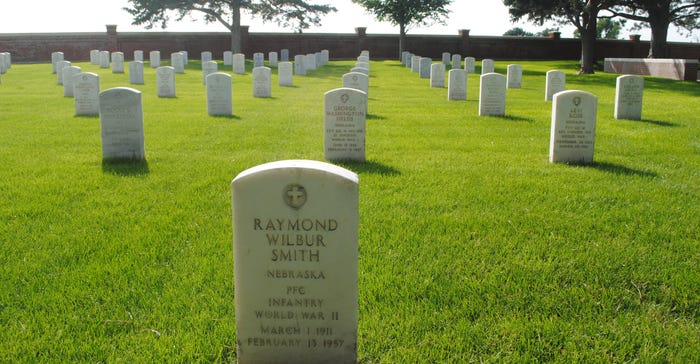
It could be called the “Arlington on the Plain,” because any visitor to the peaceful and beautiful 20-acre Fort McPherson National Cemetery 4 miles south of Maxwell, Neb., can feel the history and the legacy of those soldiers buried there.
The actual Fort McPherson was established in 1863 as Fort McKean, just above Cottonwood Canyon in Lincoln County. The mission of the outpost was to try to ensure peace between overland emigrants traveling along the Oregon Trail and Native American inhabitants. Those troops stationed at the fort initially were protecting railroad construction crews along the transcontinental route.
After the Civil War, the fort was renamed McPherson, to honor Union Gen. James B. McPherson, who was killed in the 1864 Battle of Atlanta. Two significant campaigns were launched from Fort McPherson, including a campaign against Native American tribes in Kansas in 1868, let by Lt. Col. George A. Custer and his 7th U.S. Cavalry, and an 1869 move against the Cheyenne at the Battle of Blue Summit Springs, led by Maj. Eugene Carr and his 5th U.S. Cavalry.
In 1873, the post cemetery became Fort McPherson National Cemetery. As former military posts were decommissioned on the Plains and in the mountain territories, remains from their own post cemeteries were reinterred at Fort McPherson, with the first of those arriving from Fort Kearney and Fort Sedgewick in Colorado. The remains of 389 soldiers were reinterred at Fort McPherson in 1874, with 271 of them unidentified.
As traffic along the overland routes declined with the completion of the transcontinental railroad, the fort was decommissioned in 1880. The cemetery was consolidated into the 20-acre tract that we know today, and a lodge was built at the site in 1876.
Notable burials
There are many notable soldiers buried at Fort McPherson, including Baptiste “Little Bat” Garnier, who was a scout of Oglala-Lakota and French descent, and served during the Indian Wars. Reinterred from Fort Robinson, he was known for his ability to track in impossible conditions, earning him the nickname, “Chief of Fort Robinson scouts.”
The Pawnee Indian scout Spotted Horse was killed by a Brule Sioux in 1862 and was interred at Fort Kearney. In 1873, he was reinterred at Fort McPherson. The cemetery is the final resting place for 63 Buffalo Soldiers who served in the 9th and 10th Cavalry and were reinterred from Fort Robinson.
In section A, graves 384-389, six members of Company F, 3rd U.S. Cavalry — who drowned on May 31, 1873, in a flash flood that swept through their Blackwood Creek campsite in the Republican River valley — are buried. Twenty-eight soldiers led by Lt. John L. Grattan who were killed in an encounter with the Sioux in 1854 near Fort Laramie are buried in a group at Fort McPherson.
Pvt. Cyrus Fox, 7th Iowa Cavalry, and the last-known surviving Union veteran from the Civil War living in Lincoln County, was buried at Fort McPherson in 1942. He had served under Gen. McPherson, the namesake of the original fort and the cemetery.
Cemetery today
Today, the cemetery continues to bury U.S. veterans, with well over 10,000 total interments. A digital carillon system, donated by American Veterans Inc., Department of Nebraska, rings during the week to mark the time of day, and plays devotional music on the weekends.
Available to casketed and cremated remains, burial at Fort McPherson and any national cemetery is open officially to all members of the armed forces who have met a minimum activity duty service requirement and were discharged under conditions other than dishonorable.
A veteran’s spouse, widow or widower, minor dependent children, and under certain circumstances, unmarried adult children with disabilities may also be eligible for burial.
If you drive about a mile southeast of the cemetery entrance, you will notice a monument that marks the site of the flagstaff of the old Fort McPherson military post.
Learn more online at cem.va.gov.
About the Author(s)
You May Also Like






